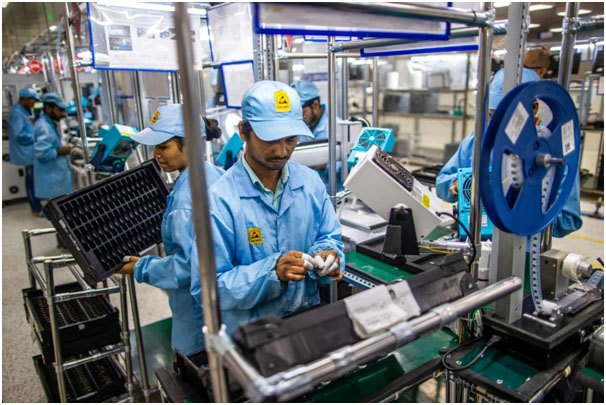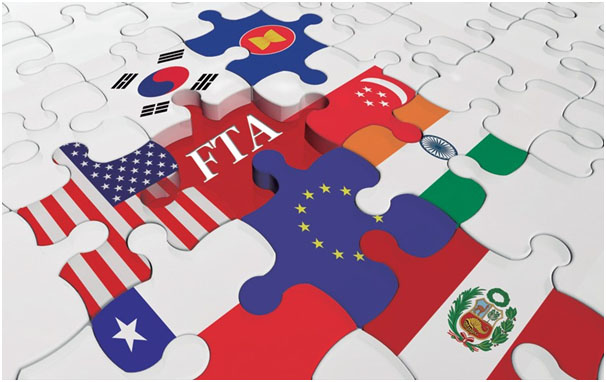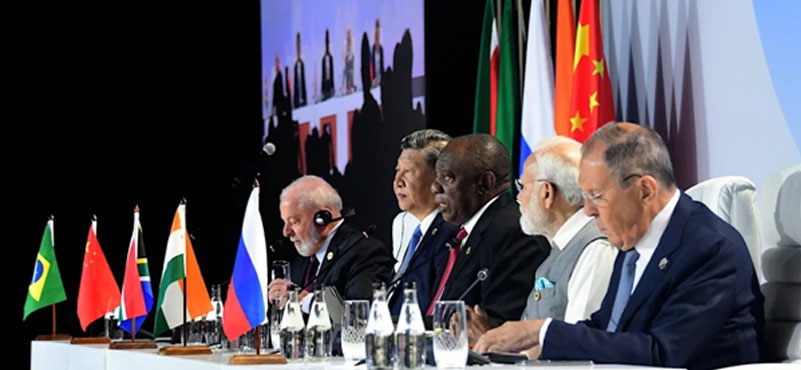President Donald Trump’s ill-conceived policies (the “Theatre of the Absurd”!) have evoked widespread development discourse and thrown the global economy into a tailspin in ways few would have imagined. Jonathan Alter, an eminent journalist, wrote, “All Presidents are blind dates”. Interestingly, the US GDP is likely to fall by 40-50 bps, inflation rise by 2%, and the currency faces a greater risk of downgrades compared to India. US tariffs are projected to cost the average U.S. household about $2,400 in the short term, mainly due to higher prices from tariff-driven inflation. Low-income families may lose around $1,300, nearly triple the relative burden compared to high earners, while high-income households could face losses of up to $5,000, though with less impact on their overall financial stability. The unravelling of the blind date comes at a heavy cost, the cookie crumbles, and how!
With almost 30 % of total global spending and about $ 5 trillion stock of foreign direct investment (FDI) (the largest globally), the USA remains the pivot of the global economy- the real mover and shaker. Trump’s fulfillment of his promise of “making America great again” (MAGA) is making the world work again. Such aggressive views and evident backsliding can be substantiated by the theoretical underpinnings provided in a book called No Trade Is Free (2023) by Robert Lighthizer, who was the former US Trade Representative (USTR) in the first Trump administration. Lighthizer strongly argued for “fair trade” rather than free trade since the untrammelled play of market forces- Adam Smith’s “invisible hand”- hurt American strategic interests. This marked a tipping point in global trade relations, characterized by protectionism, bilateralism, and strategic decoupling. While the primary target of Trump’s tariff regime was China, the ripple effects extended globally, impacting allies, emerging markets, and developing economies, including India.
President Trump has always made a strong case for “the America First foreign policy”. But he would have done well to realize “the best laid plans of mice and men often go astray”.

Sprouting Pain Points
Contrary to Trump’s view that boosting manufacturing and foreign investment in America will lead to mutual benefits, this approach will not create a win-lose situation but a lose-lose scenario where all participants in global trade become worse off. This results in a vicious cycle of higher costs for imported goods, rising inflation, fragile trade relations, decreased trade volume, and declining economic growth and confidence from investors and consumers.
World trade expanded 400-fold from $60 billion in 1947 to $25 trillion in 2023, while global growth increased only 26 times. This rapid growth was driven by countries lowering tariffs and opening markets, making cross-border trade easier and cheaper. Most of these tariff reductions were initially carried out by the GATT and later by the WTO.
The Latin phrase “res ipsa loquitur” (the thing speaks for itself) suggests that one of the main reasons for America’s prosperity is its vast internal free trade area. It is, therefore, unwise to ignore the Smoot-Hawley Tariff of 1930, which worsened an already bad recession and drove the American economy into a deep depression– a classic case of the Cobra Effect, where good intentions backfire spectacularly, undermining the core principles of capitalism and free trade. What America needs today is competitiveness, not higher tariffs. Shared prosperity depends on a more connected, secure, and efficient trading environment. The reasons for the so-called ‘tariff terrorism’ include internal weaknesses such as asset monetization, lower crude prices, lower interest rates, a weaker dollar, and resurgent manufacturing in the US.

Smelling the Coffee- An Indian Prism
Under President Trump, the United States aggressively pursued a protectionist trade agenda comprising invoking Section 232 (national security) to impose tariffs on steel (25%) and aluminium (10%) globally; using Section 301 to levy up to 25% tariffs on $370 billion worth of Chinese goods; withdrawing India from the Generalized System of Preferences (GSP) in 2019, affecting Indian exports worth over $6 billion annually; and imposing tariffs on specific goods such as auto parts, textiles, and chemicals, with India facing retaliatory measures. Although these tariffs were part of Trump’s “America First” strategy to revive domestic manufacturing and reduce trade deficits, they had far-reaching implications for emerging economies dependent on export-led growth.
The USA imposed another 25% tariffs on August 6, 2025, raising the total tariff level to 50 % by referencing high Indian tariffs, trade barriers, and India’s ongoing purchases of oil and military equipment from Russia. The U.S. also criticized India’s non-tariff measures, such as strict agricultural subsidies, sanitary and phytosanitary rules, and import quality standards, which limit market access for American products, especially in agriculture and dairy. Behind this seemingly moralistic stance lies a deeper, more transactional motive: oil and arms sales.
While these claims are partially valid, a closer look reveals that this flawed logic is problematic in theory and unacceptable in practice. It violates WTO’s core principles, including Most Favoured Nation (MFN) and the Special and Differential Treatment (S&DT), and must be strongly opposed. Both GATT and WTO have long supported tariff reductions, rule-setting, and dispute resolution to promote fair, transparent, and predictable trade. The US’s move to bypass multilateral agreements has been reasonably called the rise of ‘coercive bilateralism’. This measure is especially significant because India-US trade was $129.2 billion in 2024, with India’s trade surplus at $46 billion. It will harm India because countries like Vietnam have tariffs as low as 20%, Indonesia 19%, and Japan and South Korea 15%, giving them a competitive edge. Consequently, India could face export losses nearing $20 billion (about ₹1.75 lakh crore) in FY 26.

Triff Tirade-This time is different
While the US remains India’s largest trading partner and the top destination for exports (about 16% share in FY25, according to the Ministry of Commerce and Industry, Government of India), India has diversified its export destinations, with the top 10 countries accounting for approximately 53% of total exports. From a proper historical and comparative perspective, trade disputes between the US and India over agricultural and industrial products are not new. However, with tariffs becoming a regular tactic for President Trump, Indian industries must reposition themselves strategically, accelerate FTAs (e.g., India-UK, India-EU, India-GCC) to reflect current global realities, and strengthen and reform multilateralism.
These FTAs cannot fully compensate for the impact of increased tariffs by the US. Nonetheless, such FTAs may help cushion the effects of higher US tariffs to some extent and are thus welcomed both politically and economically in the pursuit of deeper market access, regulatory cooperation, and innovative partnerships. India should leverage the WTO Dispute Settlement Mechanism to challenge unjustified tariffs in a coordinated, urgent manner.
Utilizing Production-Linked Incentive (PLI) Schemes to boost local manufacturing across sectors (EVs, solar, electronics, auto parts, etc.) can reduce import reliance and increase exports; explore rupee-based trade with countries like Russia, Iran, and African nations to avoid dollar-denominated volatility and sanctions-related obstacles; upgrade port, cold chain, and warehousing infrastructure under PM Gati Shakti to support smooth import/export operations; invest in digital traceability (especially for agricultural exports); and promote “Brand India” campaigns globally.

Given this pivotal moment in US-India relations, domestic firms and industries must retool their inputs, outputs, and finished products to cut costs, enhance operational efficiency, and maintain an uninterrupted supply chain for growth, structural transformation, and resilience. This is crucial, as India’s manufacturing share in GDP remains unacceptably low at 13%. At the national level, India should continue negotiations and use back-door channels to reduce tariffs through a strategic mix of defensive and offensive strategies across key sectors, aiming to protect economic interests, ensure supply chain continuity, and keep exports competitive. Moreover, like Brazilian negotiators, India should also leverage its US clients to advocate on its behalf. Blinking is not an option; when the going gets tough, the tough get going.
Trump’s 25% tariff on Indian merchandise marks a low point in the US-India relationship, impacting multiple export sectors. Major export-driven sectors, e.g., textiles, gems and jewellery, leather, chemicals, and engineering goods, could suffer as the rupee weakens and investor confidence dips. In the engineering sector alone, India exported goods worth over $20 billion in FY25, including steel and aluminium, both of which already face sector-specific tariffs of up to 50%. Indian exports of pharmaceuticals, active pharmaceutical ingredients (APIs), electronics, semiconductors, smartphones, computers, and energy products continue to enjoy zero duty. These exempted goods account for about $30 billion in exports. However, the US has warned that these exemptions might not last, and duties could be applied to these sectors in the future.
Macroeconomic Impact on India
1. Trade Balance and Export Performance
Trump’s tariff measures directly reduced the competitiveness of Indian goods in the U.S., India’s largest export destination. Key impacts included decline in merchandise exports to the U.S., especially in sectors like pharmaceuticals, textiles, automotive components, and processed foods; loss of preferential market access post-GSP withdrawal, with an estimated revenue loss of $240 million per year for Indian exporters; and export growth decelerated from 12.8% in FY2018 to 2.9% in FY2020, with the U.S. tariffs as a contributing factor.
2. Foreign Direct Investment (FDI) and Investor Sentiment
The unpredictable U.S. trade policy created volatility in global capital markets. Although India attracted FDI inflows during 2019–20, partly due to U.S.-China decoupling, the larger uncertainty led to delays in cross-border investments due to fears of secondary sanctions or future tariff risks and concerns among U.S.-based investors about India’s policy stability, especially after retaliatory tariff responses by India.
3. Impact on GDP and Employment
With export sectors slowing down, the employment elasticity of exports became a concern. Labor-intensive sectors like textiles, leather, and gems & jewellery reported job losses and reduced working hours in export-oriented manufacturing zones. MSMEs, which contribute around 48% of India’s exports, were particularly affected, limiting their capacity for wage growth and investment. Although India’s GDP growth deceleration during 2019–2020 was multifactorial, external trade tensions contributed to an atmosphere of uncertainty that impacted investment and private consumption.
4. Impact on Indian Currency
The imposition of tariffs by the US can also affect the Indian rupee. A decline in foreign investment and a decrease in exports can lead to a depreciation of the Indian rupee against the US dollar. A weaker rupee can make imports more expensive, leading to higher inflation and increased costs for Indian businesses.
5. Impact on Indian Exports
The imposition of tariffs by the US can lead to a decline in Indian exports to the US resulting in a significant loss of revenue for Indian exporters and job losses in the export-oriented sectors. According to the Indian Brand Equity Foundation’s report, the US is one of the largest markets for Indian exports, including textiles, gems and jewellery, and machinery.
6. Impact on Indian Industries
The imposition of tariffs by the US can also affect Indian industries that use imported raw materials and components. The increase in the cost of imports can lead to higher production costs for Indian industries, making them less competitive in the global market. This can result in a decline in exports and a loss of market share for Indian industries.
Sectoral Impact on Major Export-Oriented Sectors
1. Textiles and Apparel
The textiles sector is one of the largest employers in India and is heavily dependent on exports. India’s textile exports to the U.S. suffered a double whammy because the loss of GSP benefits raised landed costs by 8–10% and intensified competition from Vietnam and Bangladesh, who retained preferential access to the U.S. market. Apparel exports, particularly cotton garments, will decline with eroded price competitiveness.
2. Pharmaceuticals
India’s pharma exports to the U.S. (~$6.5 billion in 2019) faced the following challenges of heightened regulatory scrutiny and tariff uncertainty, especially with India’s price control regime for generic drugs causing friction with U.S. lobby groups. Though not directly hit by high tariffs, sentiment and supply chain risk perception grew among U.S. buyers.
3. Auto Sector
The US is a major market, accounting for close to one-third (USD 8.72 billion) of India’s global exports of drug formulations and biologicals. The Indian auto industry could focus on increasing exports to other countries, such as those in the Middle East or Africa, to mitigate the impact of tariffs, consider providing incentives for the auto industry to invest in domestic production and reduce external dependence, and emphasise producing electric or hybrid vehicles, which are in high demand globally.
4. Automobile Components
With Trump threatening high tariffs (up to 25%) on auto imports globally, Indian auto parts manufacturers faced delayed contracts and cautious procurement by U.S. buyers. There is also a shift toward ‘Buy American’ sourcing, reducing India’s growth potential in the sector.
5. Agricultural Products
Given the criticality of agriculture for lives and livelihoods and the impact of agriculture on income, output, and employment, India must mount a strong push-back and not compromise on ring-fencing agriculture and dairy. Products like basmati rice, spices, and seafood lost cost competitiveness. U.S. lobby groups pressed for better market access in India, especially for dairy and poultry, straining bilateral trade ties. India could focus on increasing agricultural exports to other countries, such as those in the Middle East or Africa. The government could also consider providing incentives for farmers to invest in modern farming techniques and technology to improve productivity. Additionally, India could focus on exporting value-added agricultural products, such as processed foods or organic products.
6. Steel and Aluminium
The increase in the cost of imports of steel and aluminium led to higher production costs for Indian industries that use these metals as inputs.
India’s $1.5 billion in steel exports to the U.S. were hit by the 25% tariffs under Section 232. Consequently, Indian steelmakers redirected supply to other markets, often at discounted prices, affecting margins. India imposed retaliatory tariffs on 28 U.S. products, such as almonds and apples, affecting importers and raising tensions.
7. Oil Sector
India could diversify its oil imports by increasing purchases from countries like Iraq, Saudi Arabia, and the United Arab Emirates. The Indian government could also focus on strengthening trade relations with these countries to ensure a stable supply of oil. Additionally, India could consider increasing its domestic oil production and investing in renewable energy sources to reduce its dependence on imports.
8. Gems and Jewellery
The US tariffs increased the cost of imports of precious metals, making it more expensive for Indian businesses to manufacture gems and jewellery.
9. Palm Oil Sector
India could diversify its palm oil imports by increasing purchases from countries like Indonesia, Malaysia, and Thailand. The government could also consider reducing tariffs on palm oil imports to make it more competitive with other edible oils. Additionally, India could focus on increasing domestic production of palm oil and investing in sustainable palm oil production practices.
Challenges and Risk Factors for India
1. Loss of Preferential Access
The GSP withdrawal was a stark reminder of the vulnerability of India’s trade strategy, which often relied on unilateral benefits rather than reciprocal FTAs.
India does not have a trade deal with the U.S., unlike Vietnam or South Korea. This structural disadvantage exposed Indian exporters to greater tariff and non-tariff risks.
2. Weak Trade Negotiating Leverage
India’s refusal to yield on market access for U.S. dairy and medical devices limited its negotiating room. The stalling of U.S.-India trade talks during Trump’s presidency highlighted broader concerns of India’s defensive trade posture. Lack of convergence on e-commerce, digital data, and IP protection limited strategic trade partnerships.
3. Export Concentration Risk
India’s dependence on a few large markets (U.S., EU, UAE) creates a high concentration risk. Over 40% of India’s exports go to five countries. Tariff actions by any one country, especially the U.S., can create disproportionate disruptions.
4. Geopolitical and Strategic Uncertainty
Trump’s transactional approach to alliances meant that even traditional partners were not exempt from tariffs. This exposed India to unpredictable policy shifts. Linkages between strategic and trade issues, e.g., S-400 missile deal with Russia, became a trade friction point with the U.S.
The Roadmap Ahead: Strategic Policy Recommendations
1. Trade Diversification
India must diversify its export markets to reduce dependence on a few economies by strengthening trade ties with ASEAN, Africa, and Latin America and expanding into emerging markets and the global South through regional trade diplomacy and credit lines.
2. Strategic Trade Agreements
India needs to conclude bilateral and plurilateral trade agreements with tariff reduction commitments by fast-tracking pending FTAs with the EU, UK, Canada, and Australia; and reconsidering limited trade deals with the U.S. on select sectors, especially pharmaceuticals, IT services, and agricultural products.
3. Export Competitiveness and Infrastructure
Enhancing India’s export competitiveness requires investment in logistics, ports, and SEZs to reduce export costs; and boosting productivity and quality standards, especially for MSMEs.
4. Tariff Rationalization and Ease of Doing Business
High input tariffs reduce competitiveness. India must rationalize tariffs on intermediate goods and machinery, simplify trade compliance, improve customs efficiency, and reduce turnaround time (TAT).
5. Leverage Atmanirbhar Bharat and PLI Schemes
India’s Production Linked Incentive (PLI) schemes across electronics, pharma, and textiles can attract global value chains exiting China, and reduce import dependence and support value-added exports. However, these schemes must be complemented by reforms in labor laws, land access, and capital availability.
6. Technology and Digital Trade Readiness
With a growing focus on the digital economy and services trade, India must align with global norms on data protection and cross-border data flows and promote IT services and fintech exports via digital trade agreements.
Roadmap Ahead- “Hum Honge Kamyab” (we will overcome)
The Trump-era tariffs exposed critical vulnerabilities in India’s export strategy, including overdependence on a few markets, lack of FTAs, and limited value-added exports. The long-term implications of increased protectionism, geopolitical tensions, and trade unpredictability remain potent risks. The USA’s stubborn stance has created a clear dilemma for India: either make concessions in sensitive sectors or face a tariff shock that could destabilize exports and investment flows. Recalibrating India’s economic and trade policy is not an easy task. However, India’s approach to tariff impositions must balance immediate resilience with long-term competitiveness.
Concessions, especially in areas like agriculture or data governance, should be carefully weighed against their long-term economic, political, and national security impacts. By taking proactive steps to minimize their effects—such as diversifying trade partners, promoting self-reliance where possible, investing in export capacity, and strengthening trade diplomacy—India can turn this current challenge into an opportunity for structural transformation through diversification, improved competitiveness, and proactive trade diplomacy in sectors like oil, automotive, agriculture, and palm oil. As the global economy continues to grapple with new protectionist undercurrents, India must craft a resilient, forward-looking export strategy that balances self-reliance with strategic global integration to promote sustainable growth, employment generation, and macroeconomic stability in a world reshaped by tariff wars and shifting alliances.
India’s resilience in the face of pressure is not an act of defiance but one of self-preservation. Quick, coordinated actions—including tariff rationalization, attracting anchor investors, increasing participation in global value chains (GVCs), simplifying tariff structures, and lowering tariffs on imports where domestic capacity is lacking—are essential to navigate the transition and enhance competitiveness in the global economy. These measures can help India reduce its dependence on the US market and become more competitive in the global economy.
Recommendations
Based on the analysis above, the following recommendations emerge:
- Short-term Measures: In the short term, India should focus on negotiating with the US to reduce tariffs and increase market access.
- Medium-term Measures: In the medium term, India should focus on diversifying its exports, increasing competitiveness, and promoting domestic manufacturing.
- Long-term Measures: In the long term, India should focus on investing in infrastructure, encouraging foreign investment, and engaging in trade diplomacy to become more competitive in the global economy.
India can mitigate the impact of Trump’s tariffs and become more competitive in the global economy by adopting these measures.
ABOUT THE AUTHOR
 Dr. Manoranjan Sharma is Chief Economist, Infomerics, India. With a brilliant academic record, he has over 250 publications and six books. His views have been cited in the Associated Press, New York; Dow Jones, New York; International Herald Tribune, New York; Wall Street Journal, New York.
Dr. Manoranjan Sharma is Chief Economist, Infomerics, India. With a brilliant academic record, he has over 250 publications and six books. His views have been cited in the Associated Press, New York; Dow Jones, New York; International Herald Tribune, New York; Wall Street Journal, New York.








